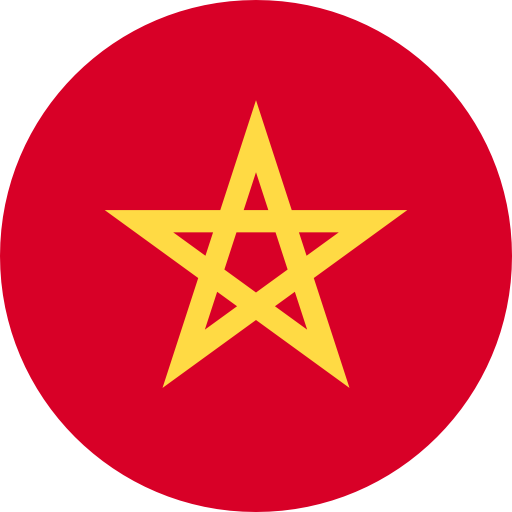About MA

Location
Morocco is located in North Africa, bordered by the Atlantic Ocean and the Mediterranean Sea to the west and north, Algeria to the east, and Western Sahara to the south.
Capital
The capital city of Morocco is Rabat, located on the Atlantic coast.
Population
As of the latest estimates, Morocco has a population of approximately 36 million people.
Area
Morocco covers a total land area of about 446,550 square kilometers (172,410 square miles).
Official Languages
The official languages of Morocco are Arabic and Berber. French is also widely spoken and used in business and education.
Government
Morocco is a constitutional monarchy with a parliamentary system. The King of Morocco, currently King Mohammed VI, serves as the head of state, while the Prime Minister is the head of government.
Independence
Morocco gained independence from France and Spain on March 2, 1956.
Currency
The currency of Morocco is the Moroccan Dirham (MAD).
Economy
Morocco has a diverse economy with agriculture, mining, tourism, and manufacturing as key sectors. The country is one of the world's largest producers of phosphates and also has significant industries in textiles, automotive, and aerospace.
Culture
Moroccan culture is a blend of Arab, Berber, African, and European influences. The country is known for its vibrant music, colorful festivals, exquisite cuisine (such as tagine and couscous), and traditional arts and crafts (such as pottery, carpets, and leatherwork).
Religion
Islam is the predominant religion in Morocco, with the majority of the population being Sunni Muslims. The country also has small Jewish and Christian communities.
Tourism
Morocco is a popular tourist destination known for its historical cities (such as Marrakech, Fes, and Casablanca), beautiful beaches, scenic landscapes (including the Atlas Mountains and the Sahara Desert), and rich cultural heritage.
Landscapes
Morocco's landscapes range from coastal plains and fertile valleys to mountain ranges and desert regions. The Atlas Mountains run through the country, dividing it into distinct geographical regions.
Challenges
Morocco faces challenges related to unemployment, poverty, and socio-economic disparities, particularly in rural areas. The country also grapples with issues such as water scarcity and environmental degradation.

National Items of Morocco
Atlas Mountains
The Atlas Mountains are a prominent mountain range in Morocco, symbolizing natural beauty, geographical diversity, and the adventurous spirit of the Moroccan people.
Argan Tree
The Argan tree, native to Morocco, produces argan oil which is used in cooking and cosmetics. It symbolizes natural resources, traditional agriculture, and economic importance.
Mint Tea
Mint tea, or "Atay," is a traditional Moroccan beverage. It symbolizes hospitality, social customs, and cultural heritage.
Couscous
Couscous is a staple dish in Moroccan cuisine made from steamed semolina. It symbolizes the rich culinary heritage and traditional foods of Morocco.
Tagine
A Tagine is a traditional North African clay cooking pot and slow-cooked stews made in it. It symbolizes the culinary traditions and rich flavors of Moroccan cuisine.
Moroccan Lantern
Traditional Moroccan lanterns, known for their intricate designs, symbolize artistic craftsmanship, cultural heritage, and the unique architectural aesthetics of Morocco.
Kaftan
The Kaftan is a traditional Moroccan garment worn by both men and women. It symbolizes cultural heritage, traditional fashion, and identity.
Rabat
Rabat, the capital city of Morocco, symbolizes the political, cultural, and historical significance of the country.
Hassan II Mosque
The Hassan II Mosque in Casablanca is one of the largest mosques in the world. It symbolizes religious significance, architectural marvel, and cultural heritage.
Moroccan Rugs
Handwoven Moroccan rugs, known for their vibrant colors and patterns, symbolize rich artisanal heritage, cultural identity, and craftsmanship.
Berber Symbols
Berber symbols and designs, often found in textiles and jewelry, symbolize the cultural heritage, identity, and artistic expression of the Berber people.
Sahara Desert
The Sahara Desert, covering the southeastern part of Morocco, symbolizes the natural beauty, vast landscapes, and the traditional nomadic lifestyle of the Saharan people.
Fes
The city of Fes, known for its ancient medina and as a center of learning, symbolizes historical heritage, cultural significance, and intellectual history.
Moroccan Spices
Traditional Moroccan spices, such as saffron, cumin, and cinnamon, symbolize the rich culinary heritage and unique flavors of Moroccan cuisine.
Camel
The camel is an important symbol in Moroccan culture, representing traditional nomadic life, endurance, and the significance of camels in transportation.
Henna
Henna, used in traditional Moroccan ceremonies and body art, symbolizes cultural heritage, artistic expression, and traditional practices.
Essaouira
Essaouira, a coastal city known for its historic medina and vibrant arts scene, symbolizes the cultural diversity, historical heritage, and natural beauty of Morocco.
Djellaba
The Djellaba is a traditional long, loose-fitting outer robe with a hood, worn by both men and women in Morocco. It symbolizes cultural heritage, traditional fashion, and identity.

This anthem reflects loyalty to the King, pride in the nation, and unity among its people, emphasizing the values of patriotism and national unity.
The national anthem of Morocco is called "Hymne Chérifien" in Arabic and "Hymne Cherifien" in French, which translates to "Cherifian Anthem" in English. Here are the lyrics in Arabic along with an English translation:
عاش المليك بيت المالك والمكان
وعاش الشعب دائما معززا مكرما
وعاشت المملكة مددا وتكاملا
شعارها الله الوطن الملك
يحيا المليك
Long live the King, the Master of the land and the place
Long live the people, ever dignified and honored
Long live the Kingdom, united and complete
Its emblem is God, Homeland, King
Long live the King


